Xoan Singing, also known as Hat Xoan, is a captivating Vietnamese performing art that holds deep cultural significance and historical roots, and SIXT.VN can guide you to experience this unique tradition firsthand. As a UNESCO-recognized intangible cultural heritage, Xoan Singing offers a glimpse into the rich heritage of Vietnam, and SIXT.VN provides seamless travel experiences, ensuring you delve into the heart of Vietnamese culture with ease. Explore Phu Tho province and the ancestral worship connected with Xoan traditions through convenient transportation, comfortable accommodations, and expertly guided tours arranged by SIXT.VN.
1. What Is Xoan Singing (Hat Xoan) and Why Is It Important?
Xoan Singing, or Hat Xoan, is a traditional Vietnamese performing art that combines singing, dancing, drumming, and clapper beating, holding a significant place in the cultural tapestry of Vietnam. This unique art form is deeply intertwined with the worship of the Hung Kings, reflecting the ancestor worship practices of the Viet people. Recognized by UNESCO as an intangible cultural heritage, Xoan Singing showcases Vietnam’s rich cultural heritage and fosters community spirit. According to UNESCO, Xoan singing is a community performing art that fosters cultural understanding, community cohesion, and mutual respect.
1.1. What Are the Historical Origins of Xoan Singing?
Xoan Singing traces its roots back to the Hung Kings period, the legendary founders of Vietnam, making it a centuries-old tradition. The art form originated in the ancient villages of Phu Tho province, the ancestral land of the Vietnamese people. Over generations, Xoan Singing has been passed down through families and communities, preserving its unique style and cultural significance. According to the Vietnam National Administration of Tourism, the tradition is closely linked to the worship of Hung Kings.
1.2. What Are the Key Elements of a Xoan Singing Performance?
A Xoan Singing performance is a multifaceted art form comprising several key elements:
- Singing: The heart of Xoan Singing lies in its unique vocal style, characterized by melodic chants and rhythmic verses.
- Dancing: Graceful and symbolic dances accompany the singing, enhancing the storytelling aspect of the performance.
- Drumming: The rhythmic beats of traditional drums provide the musical foundation for the performance.
- Clapper Beating: The distinct sound of wooden clappers adds a percussive layer, creating a lively atmosphere.
- Costumes: Performers don traditional costumes, often adorned with vibrant colors and intricate designs, reflecting the cultural identity of the art form.
1.3. Why Is Xoan Singing Recognized by UNESCO?
UNESCO recognized Xoan Singing as an intangible cultural heritage in 2017, acknowledging its cultural significance and historical value. This recognition highlights the importance of preserving and promoting this unique art form for future generations. UNESCO emphasizes that Xoan Singing fosters cultural understanding, community cohesion, and mutual respect, making it a valuable asset to Vietnamese culture.
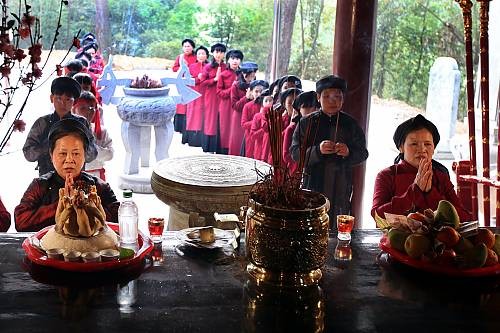 Xoan singing performance in Phu Tho province, Vietnam, featuring traditional costumes and musical instruments.
Xoan singing performance in Phu Tho province, Vietnam, featuring traditional costumes and musical instruments.
2. Who Are the Key People Involved in Preserving Xoan Singing?
The preservation of Xoan Singing relies on dedicated individuals and communities who play vital roles in safeguarding this cultural treasure.
2.1. What Role Do the “Trum” Play in Xoan Singing?
The “Trum” are key figures in Xoan Singing guilds, holding the responsibility of preserving and transmitting the art form to future generations. These experienced practitioners serve as custodians of Xoan Singing, ensuring its survival and evolution. According to the Phú Thọ Department of Culture, Sports and Tourism, the male and female Trum play the most important role; they preserve the songs, select students, transmit the singing styles and repertoires and organize practices.
2.2. How Do Xoan Singing Guilds Contribute to the Art Form’s Survival?
Xoan Singing guilds serve as centers for preserving and promoting the art form, uniting practitioners and enthusiasts. These guilds organize performances, conduct training sessions, and foster a sense of community among Xoan Singing devotees. The guilds play a crucial role in maintaining the authenticity and integrity of Xoan Singing. UNESCO states that bearers and practitioners form four guilds, in which the male and female Trum play the most important role.
2.3. What Efforts Are Being Made to Teach Xoan Singing to Younger Generations?
Recognizing the importance of ensuring the continuity of Xoan Singing, various initiatives are underway to engage younger generations. These efforts include incorporating Xoan Singing into school curricula, organizing workshops for young people, and leveraging digital platforms to reach a wider audience. Experienced artists teach Xoan singing to members of clubs and to music teachers in schools, who then transmit this knowledge to other club members and students.
3. Where Can You Experience Authentic Xoan Singing Performances?
To witness the captivating beauty of Xoan Singing, several destinations in Vietnam offer authentic performance experiences.
3.1. Why Is Phu Tho Province Considered the Heart of Xoan Singing?
Phu Tho province, the ancestral land of the Vietnamese people, is considered the heart of Xoan Singing, as it is where the art form originated and has been nurtured for centuries. The villages of Phu Tho province are home to the most renowned Xoan Singing guilds and practitioners. According to the Vietnam National Administration of Tourism, Xoan singing is closely linked to the worship of Hung Kings.
3.2. Are There Any Xoan Singing Performances Held in Hanoi?
While Phu Tho province is the epicenter of Xoan Singing, performances are also held in Hanoi, the capital of Vietnam. Cultural centers and theaters in Hanoi occasionally host Xoan Singing troupes, offering visitors a glimpse into this unique art form. SIXT.VN can help you find the venues and times for upcoming performances.
3.3. Can SIXT.VN Help Arrange a Trip to Phu Tho Province to See Xoan Singing?
Yes, SIXT.VN specializes in creating customized travel experiences, including arranging trips to Phu Tho province to witness authentic Xoan Singing performances. SIXT.VN can handle all aspects of your trip, from transportation and accommodation to guided tours and cultural immersion activities. SIXT.VN ensures a seamless and enriching experience, allowing you to fully appreciate the beauty and significance of Xoan Singing.
 Xoan singers performing traditional music and dance in Phu Tho province.
Xoan singers performing traditional music and dance in Phu Tho province.
4. How Does Xoan Singing Reflect Vietnamese Culture and Beliefs?
Xoan Singing is deeply rooted in Vietnamese culture and reflects the beliefs and values of the Vietnamese people.
4.1. What Is the Connection Between Xoan Singing and the Worship of the Hung Kings?
Xoan Singing is inextricably linked to the worship of the Hung Kings, the legendary founders of Vietnam. The performances often incorporate rituals and ceremonies honoring the Hung Kings, paying homage to their contributions to the nation’s history and culture. According to UNESCO, it is closely linked to the worship of the Hung Kings, a belief rooted in the ancestor worship practice of the Viet people.
4.2. How Does Xoan Singing Promote Community Cohesion?
Xoan Singing serves as a powerful tool for promoting community cohesion, bringing people together to celebrate their shared cultural heritage. The performances often involve participation from community members, fostering a sense of belonging and collective identity. UNESCO recognizes Xoan Singing as a community performing art that fosters cultural understanding, community cohesion, and mutual respect.
4.3. What Values Does Xoan Singing Embody?
Xoan Singing embodies several core values of Vietnamese culture, including respect for ancestors, reverence for tradition, and appreciation for beauty and harmony. The art form also promotes cultural understanding, community cohesion, and mutual respect. These values are reflected in the lyrics, melodies, and movements of Xoan Singing performances.
5. What Are the Different Types of Xoan Singing?
Xoan Singing encompasses various forms, each with its unique characteristics and significance.
5.1. What Is “Hat The”?
“Hat The” is a type of Xoan Singing performed during religious rituals and ceremonies, invoking blessings and paying homage to deities. This form of Xoan Singing is characterized by its solemnity and spiritual nature. It’s often performed at the beginning of festivals or important community events to ensure good fortune.
5.2. What Is “Hat Giao Duyen”?
“Hat Giao Duyen” is a form of Xoan Singing that involves alternating verses between male and female performers, creating a dialogue through song. This type of Xoan Singing often depicts themes of love, courtship, and social interaction. The exchange is often witty and playful, showcasing the performers’ skill and creativity.
5.3. What Is “Hat Hoi”?
“Hat Hoi” is a festive and celebratory form of Xoan Singing, performed during festivals and community gatherings. This type of Xoan Singing is characterized by its lively rhythms, upbeat melodies, and joyful atmosphere. It often includes dancing and other forms of entertainment, encouraging community participation.
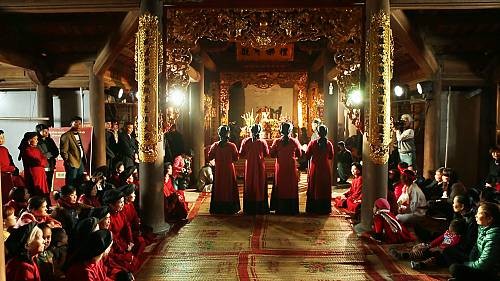 A close-up view of a Xoan singer holding traditional clappers.
A close-up view of a Xoan singer holding traditional clappers.
6. Why Is It Important to Preserve Intangible Cultural Heritage Like Xoan Singing?
Preserving intangible cultural heritage like Xoan Singing is crucial for maintaining cultural diversity, promoting understanding, and fostering a sense of identity.
6.1. How Does Intangible Cultural Heritage Contribute to Cultural Diversity?
Intangible cultural heritage, including traditions like Xoan Singing, represents the unique expressions and practices of different communities, contributing to the richness and diversity of human culture. By preserving these traditions, we safeguard the cultural mosaic of our world. UNESCO recognizes that intangible cultural heritage provides different communities with a sense of identity and continuity.
6.2. How Does Preserving Xoan Singing Promote Cultural Understanding?
By learning about and appreciating traditions like Xoan Singing, we gain insights into the values, beliefs, and perspectives of different cultures, fostering mutual understanding and respect. Cultural exchange helps break down barriers and promotes peaceful coexistence. Experiencing Xoan Singing offers a deeper understanding of Vietnamese history and traditions.
6.3. What Is the Role of Xoan Singing in Shaping Vietnamese Identity?
Xoan Singing plays a significant role in shaping Vietnamese identity, connecting people to their ancestral roots and fostering a sense of belonging to a shared cultural heritage. It instills pride in Vietnamese culture and promotes a sense of national unity. By participating in and preserving Xoan Singing, Vietnamese people reaffirm their cultural identity.
7. How Can You Support the Preservation of Xoan Singing?
There are several ways to support the preservation of Xoan Singing and other forms of intangible cultural heritage.
7.1. What Are Some Organizations Dedicated to Preserving Vietnamese Culture?
Several organizations are dedicated to preserving Vietnamese culture, including Xoan Singing. These organizations often conduct research, organize educational programs, and provide financial support for cultural preservation initiatives. The Vietnamese Institute for Musicology has collected 31 Xoan songs.
7.2. How Can You Participate in Cultural Preservation Efforts as a Tourist?
As a tourist, you can contribute to cultural preservation efforts by visiting cultural sites, attending traditional performances, and purchasing locally made crafts. By supporting local artisans and cultural practitioners, you help sustain traditional art forms and promote economic development in local communities. SIXT.VN can help you identify ethical and sustainable tourism options.
7.3. What Is the Role of Responsible Tourism in Protecting Cultural Heritage?
Responsible tourism plays a crucial role in protecting cultural heritage by promoting sustainable practices that minimize the negative impacts of tourism on local cultures and environments. This includes respecting local customs, supporting local businesses, and avoiding activities that may damage cultural sites or exploit local communities. SIXT.VN is committed to responsible tourism practices.
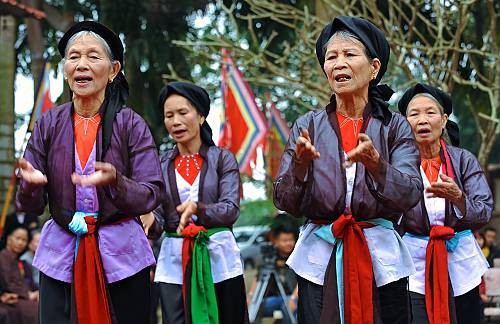 Xoan singers preparing for a performance, showcasing traditional instruments.
Xoan singers preparing for a performance, showcasing traditional instruments.
8. What Are the Challenges Facing Xoan Singing Today?
Despite its cultural significance, Xoan Singing faces several challenges that threaten its survival.
8.1. How Does Modernization Impact Traditional Art Forms Like Xoan Singing?
Modernization can pose a threat to traditional art forms like Xoan Singing by leading to a decline in interest among younger generations and a shift towards more contemporary forms of entertainment. As lifestyles change, traditional cultural practices may be seen as less relevant or appealing. Maintaining the relevance of Xoan Singing in a modern context is a key challenge.
8.2. What Is the Impact of Tourism on Xoan Singing?
While tourism can provide economic benefits to communities that practice Xoan Singing, it can also have negative impacts if not managed responsibly. Over-commercialization of Xoan Singing for tourist consumption can lead to a loss of authenticity and a decline in the quality of performances. Sustainable tourism practices are essential to mitigate these risks.
8.3. How Can We Ensure the Sustainability of Xoan Singing for Future Generations?
Ensuring the sustainability of Xoan Singing for future generations requires a multi-faceted approach, including promoting cultural education, supporting cultural practitioners, and fostering a sense of pride in Vietnamese cultural heritage. Encouraging youth participation in Xoan Singing is crucial for its long-term survival. Leaders and senior Xoan artists transmit the singing orally, combined with the use of written songs and audio and visual recordings.
9. How Can SIXT.VN Enhance Your Cultural Experience in Vietnam?
SIXT.VN offers a range of services designed to enhance your cultural experience in Vietnam, ensuring a seamless and enriching journey.
9.1. What Travel Services Does SIXT.VN Offer for Tourists Visiting Vietnam?
SIXT.VN provides comprehensive travel services, including airport transfers, hotel bookings, tour packages, and transportation rentals, catering to the needs of tourists visiting Vietnam. SIXT.VN simplifies travel planning, allowing you to focus on experiencing the beauty and culture of Vietnam.
9.2. How Can SIXT.VN Help You Discover Authentic Cultural Experiences?
SIXT.VN partners with local experts to curate authentic cultural experiences, including visits to traditional villages, participation in cultural festivals, and opportunities to interact with local artisans and performers. SIXT.VN provides access to unique and immersive cultural encounters.
9.3. What Makes SIXT.VN the Ideal Travel Partner for Exploring Vietnamese Culture?
SIXT.VN is committed to responsible tourism practices, ensuring that your travels benefit local communities and minimize negative impacts on the environment and cultural heritage. SIXT.VN prioritizes sustainable tourism, making it the ideal travel partner for exploring Vietnamese culture. By choosing SIXT.VN, you support the preservation of Vietnamese traditions.
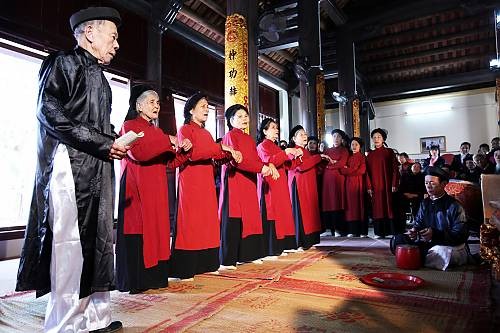 Xoan singers in vibrant costumes posing for a group photo after a performance.
Xoan singers in vibrant costumes posing for a group photo after a performance.
10. What Are Some Other Intangible Cultural Heritage Elements in Vietnam?
Vietnam boasts a rich tapestry of intangible cultural heritage elements beyond Xoan Singing, showcasing the country’s diverse traditions and artistic expressions.
10.1. What Is “Ca Tru” Singing?
“Ca Tru” is a complex form of chamber music featuring female vocalists accompanied by instrumentalists, known for its sophisticated lyrics and intricate melodies. This art form was once a popular form of entertainment in royal courts and aristocratic circles. Ca Tru is a unique blend of poetry, music, and performance.
10.2. What Is “Quan Ho” Folk Singing?
“Quan Ho” folk singing is a tradition of alternating verses between male and female singers, typically performed during festivals and community gatherings in the Red River Delta region. This art form is characterized by its romantic themes, playful banter, and vibrant costumes. Quan Ho singing promotes community cohesion and cultural exchange.
10.3. What Is “Gong Culture in the Central Highlands of Vietnam”?
The “Gong Culture in the Central Highlands of Vietnam” encompasses the beliefs, rituals, and artistic expressions associated with the use of gongs in the region. Gongs are considered sacred instruments and are used in various ceremonies and festivals. The gong culture reflects the unique cultural identity of the ethnic groups in the Central Highlands.
11. What Are the Benefits of Experiencing Cultural Tourism in Vietnam?
Cultural tourism in Vietnam offers numerous benefits, both for tourists and local communities.
11.1. How Does Cultural Tourism Support Local Economies?
Cultural tourism can generate significant revenue for local economies by creating jobs, supporting local businesses, and promoting the sale of traditional crafts and products. By spending money on local goods and services, tourists contribute to the economic well-being of local communities. Sustainable tourism practices maximize these economic benefits.
11.2. How Does Cultural Tourism Promote Intercultural Understanding?
Cultural tourism provides opportunities for tourists to interact with local people, learn about their traditions, and gain insights into their way of life, fostering intercultural understanding and respect. Cultural exchange helps break down stereotypes and promotes empathy. Experiencing Xoan Singing firsthand promotes cultural exchange and understanding.
11.3. How Does Cultural Tourism Contribute to the Preservation of Cultural Heritage?
By creating demand for traditional arts and cultural experiences, cultural tourism can incentivize local communities to preserve their cultural heritage and pass it on to future generations. Tourism revenue can be used to support cultural preservation initiatives and protect cultural sites. Responsible tourism practices ensure that cultural heritage is preserved for future generations.
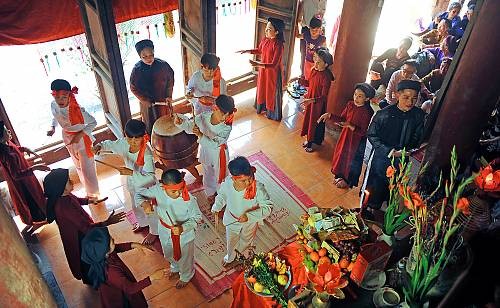 Elderly Xoan singers passing down their knowledge to younger performers in a workshop.
Elderly Xoan singers passing down their knowledge to younger performers in a workshop.
12. What Are Some Tips for Planning a Cultural Trip to Vietnam?
Planning a cultural trip to Vietnam requires careful consideration of various factors, including visa requirements, transportation options, and cultural etiquette.
12.1. What Are the Visa Requirements for Visiting Vietnam?
Visa requirements for visiting Vietnam vary depending on your nationality and the length of your stay. It’s essential to check the latest visa regulations and apply for a visa in advance to avoid any travel disruptions. SIXT.VN can provide assistance with visa applications.
12.2. What Are the Best Ways to Get Around Vietnam?
Vietnam offers various transportation options, including domestic flights, trains, buses, and taxis. The best way to get around depends on your budget, time constraints, and travel preferences. SIXT.VN provides transportation rental services for tourists in Vietnam.
12.3. What Are Some Important Cultural Customs to Be Aware Of in Vietnam?
When visiting Vietnam, it’s important to be aware of local customs and etiquette to show respect for Vietnamese culture. This includes dressing modestly when visiting temples and pagodas, avoiding public displays of affection, and using both hands when giving or receiving items. Learning a few basic Vietnamese phrases can also enhance your cultural experience.
13. What Are the Top Destinations for Cultural Immersion in Vietnam?
Vietnam offers numerous destinations for cultural immersion, each with its unique attractions and cultural experiences.
13.1. Why Is Hanoi a Great Place to Experience Vietnamese Culture?
Hanoi, the capital of Vietnam, is a vibrant city with a rich history and a thriving cultural scene. The city is home to numerous museums, temples, and historical sites, offering visitors a glimpse into Vietnam’s past. Hanoi’s Old Quarter is a maze of narrow streets filled with traditional shops, art galleries, and street food vendors.
13.2. What Cultural Attractions Does Hoi An Offer?
Hoi An, a UNESCO World Heritage Site, is a charming ancient town known for its well-preserved architecture, tailor shops, and delicious cuisine. The town’s narrow streets are lined with colorful buildings, creating a picturesque atmosphere. Hoi An is also home to several traditional craft villages, where you can learn about pottery, lantern making, and silk weaving.
13.3. Why Should You Visit Hue for a Cultural Experience?
Hue, the former imperial capital of Vietnam, is a city steeped in history and culture. The city is home to numerous imperial tombs, temples, and pagodas, showcasing the grandeur of the Nguyen Dynasty. Hue’s cuisine is also renowned for its sophisticated flavors and presentation.
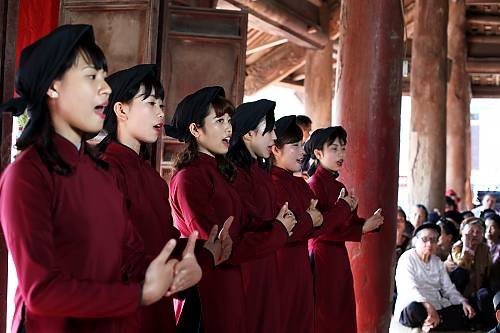 Performers showcase the intricate drumming techniques used in Xoan singing.
Performers showcase the intricate drumming techniques used in Xoan singing.
14. How Can You Combine a Cultural Trip with Other Travel Experiences in Vietnam?
Vietnam offers a diverse range of travel experiences that can be combined with a cultural trip, catering to various interests and preferences.
14.1. How Can You Combine Cultural Tourism with Adventure Travel in Vietnam?
Vietnam’s diverse landscape provides opportunities for adventure travel, including trekking in the mountains, kayaking in Ha Long Bay, and exploring caves in Phong Nha-Ke Bang National Park. Combining cultural tourism with adventure travel allows you to experience both the cultural heritage and natural beauty of Vietnam.
14.2. How Can You Combine Cultural Tourism with Beach Relaxation in Vietnam?
Vietnam boasts a long coastline with numerous stunning beaches, offering opportunities for relaxation and water sports. Combining cultural tourism with beach relaxation allows you to balance cultural exploration with leisure and recreation. Destinations like Nha Trang, Phu Quoc, and Da Nang offer both cultural attractions and beautiful beaches.
14.3. How Can You Combine Cultural Tourism with Culinary Experiences in Vietnam?
Vietnamese cuisine is renowned for its fresh ingredients, vibrant flavors, and regional diversity. Combining cultural tourism with culinary experiences allows you to explore Vietnam’s cultural heritage through its food. Taking cooking classes, visiting local markets, and sampling street food are great ways to immerse yourself in Vietnamese culinary culture.
15. How Does Xoan Singing Contribute to Sustainable Tourism in Vietnam?
Xoan Singing plays a vital role in promoting sustainable tourism in Vietnam by attracting visitors to local communities, supporting local economies, and preserving cultural heritage.
15.1. How Does Xoan Singing Attract Tourists to Local Communities?
Xoan Singing performances and cultural events attract tourists to local communities, providing opportunities for economic development and cultural exchange. By showcasing the unique cultural heritage of these communities, Xoan Singing helps promote sustainable tourism.
15.2. How Does Tourism Related to Xoan Singing Support Local Economies?
Tourism related to Xoan Singing generates revenue for local economies by creating jobs, supporting local businesses, and promoting the sale of traditional crafts and products. This revenue can be used to improve infrastructure, support education, and preserve cultural heritage.
15.3. How Does Xoan Singing Help Preserve Cultural Heritage Through Tourism?
By creating demand for Xoan Singing performances and cultural experiences, tourism incentivizes local communities to preserve their cultural heritage and pass it on to future generations. Tourism revenue can be used to support cultural preservation initiatives and protect cultural sites.
16. What Are the Future Prospects for Xoan Singing?
The future prospects for Xoan Singing depend on continued efforts to promote, preserve, and sustain this unique art form for future generations.
16.1. What Initiatives Are Being Undertaken to Ensure the Survival of Xoan Singing?
Various initiatives are being undertaken to ensure the survival of Xoan Singing, including cultural education programs, financial support for cultural practitioners, and promotion of Xoan Singing performances and events. These initiatives aim to raise awareness of Xoan Singing and encourage younger generations to participate in its preservation.
16.2. What Role Can Technology Play in Preserving Xoan Singing?
Technology can play a significant role in preserving Xoan Singing by providing digital platforms for recording, archiving, and sharing performances. Online resources can also be used to educate people about Xoan Singing and promote its cultural significance. Social media can be used to reach wider audiences and engage younger generations.
16.3. How Can Individuals Contribute to the Future of Xoan Singing?
Individuals can contribute to the future of Xoan Singing by attending performances, supporting cultural practitioners, and promoting awareness of this unique art form. By learning about Xoan Singing and sharing their knowledge with others, individuals can help ensure that it continues to thrive for generations to come.
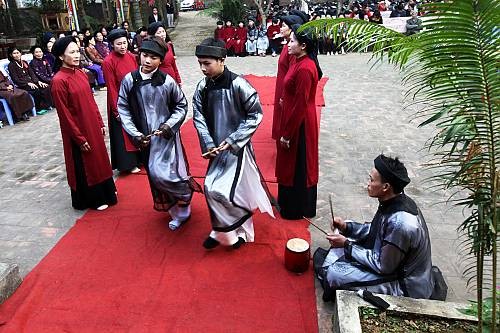 A Xoan singing master teaching the art form to a young student.
A Xoan singing master teaching the art form to a young student.
17. What Are Some Common Misconceptions About Xoan Singing?
There are several common misconceptions about Xoan Singing that need to be addressed to promote a better understanding of this unique art form.
17.1. Is Xoan Singing Only for the Elderly?
While Xoan Singing has traditionally been practiced by older generations, efforts are being made to engage younger people and ensure its continuity. Many young people are now learning and performing Xoan Singing, dispelling the misconception that it is only for the elderly.
17.2. Is Xoan Singing Just a Form of Entertainment?
While Xoan Singing can be entertaining, it is more than just a form of entertainment. It is a cultural tradition with deep historical roots and spiritual significance. Xoan Singing is closely linked to the worship of the Hung Kings and plays a vital role in promoting community cohesion.
17.3. Is Xoan Singing the Same as Other Forms of Vietnamese Folk Music?
While Xoan Singing is a form of Vietnamese folk music, it is distinct from other forms due to its unique vocal style, rhythmic patterns, and cultural context. Xoan Singing is characterized by its solemnity, spirituality, and close connection to the worship of the Hung Kings.
18. How Can You Learn More About Xoan Singing?
There are several ways to learn more about Xoan Singing, including visiting cultural centers, attending performances, and consulting online resources.
18.1. What Are Some Recommended Books and Articles About Xoan Singing?
Several books and articles provide detailed information about Xoan Singing, including its history, cultural significance, and musical characteristics. Consulting academic journals, cultural publications, and online databases can provide valuable insights. The Vietnamese Institute for Musicology is a valuable resource for information about Xoan Singing.
18.2. What Are Some Online Resources for Learning About Xoan Singing?
Several online resources offer information about Xoan Singing, including websites of cultural organizations, academic institutions, and tourism agencies. Online videos, audio recordings, and interactive exhibits can provide a more immersive learning experience. UNESCO’s website provides information about Xoan Singing as an intangible cultural heritage.
18.3. Are There Any Workshops or Classes Available for Learning Xoan Singing?
Workshops and classes are available for learning Xoan Singing, offering opportunities to develop your skills and knowledge under the guidance of experienced practitioners. These workshops and classes are often organized by cultural centers, music schools, and Xoan Singing guilds. Participating in a workshop is a great way to immerse yourself in the art form.
 The rhythmic beating of clappers is a distinct feature of Xoan singing performances.
The rhythmic beating of clappers is a distinct feature of Xoan singing performances.
19. What Is the Role of Government in Preserving Xoan Singing?
The government plays a crucial role in preserving Xoan Singing by providing funding, enacting legislation, and promoting cultural education.
19.1. What Policies and Programs Does the Vietnamese Government Have in Place to Support Cultural Heritage?
The Vietnamese government has implemented various policies and programs to support cultural heritage, including providing financial assistance to cultural organizations, establishing cultural heritage sites, and promoting cultural tourism. These policies and programs aim to protect and preserve Vietnam’s rich cultural heritage.
19.2. How Does the Government Work with Local Communities to Preserve Xoan Singing?
The government works with local communities to preserve Xoan Singing by providing funding for cultural activities, supporting the training of cultural practitioners, and promoting community participation in cultural preservation efforts. This collaborative approach ensures that cultural preservation efforts are aligned with the needs and priorities of local communities.
19.3. What International Agreements Does Vietnam Participate In to Protect Intangible Cultural Heritage?
Vietnam participates in various international agreements to protect intangible cultural heritage, including the UNESCO Convention for the Safeguarding of the Intangible Cultural Heritage. These agreements commit Vietnam to protect and promote its intangible cultural heritage, including Xoan Singing.
20. What Are the Ethical Considerations When Experiencing Cultural Tourism?
When experiencing cultural tourism, it’s essential to be mindful of ethical considerations to ensure that your travels benefit local communities and minimize negative impacts on the environment and cultural heritage.
20.1. How Can You Ensure That Your Tourism Activities Benefit Local Communities?
You can ensure that your tourism activities benefit local communities by supporting local businesses, purchasing locally made products, and choosing tour operators that prioritize responsible tourism practices. Avoiding activities that may exploit local communities or damage cultural sites is also essential.
20.2. How Can You Respect Local Customs and Traditions When Traveling?
You can respect local customs and traditions by dressing modestly when visiting temples and pagodas, avoiding public displays of affection, and learning a few basic phrases in the local language. Being mindful of local etiquette and showing respect for local beliefs can enhance your cultural experience and promote positive interactions with local people.
20.3. How Can You Minimize Your Environmental Impact When Traveling?
You can minimize your environmental impact by using public transportation, reducing your consumption of single-use plastics, and choosing eco-friendly accommodations. Supporting sustainable tourism initiatives and respecting local environmental regulations is also essential.
Ready to immerse yourself in the captivating world of Xoan Singing and explore the cultural treasures of Vietnam? Let SIXT.VN be your trusted travel partner. Contact us today at +84 986 244 358 or visit our website at SIXT.VN to discover our exclusive tour packages, convenient airport transfer services, and comfortable hotel accommodations. Our address is 260 Cau Giay, Hanoi, Vietnam. Let SIXT.VN help you create unforgettable memories in Vietnam!
FAQ About Xoan Singing (Hat Xoan)
1. What is the meaning of the word “Xoan” in Xoan Singing?
The exact meaning of “Xoan” is debated, but it is believed to refer to the spring season, renewal, and the blossoming of culture and art.
2. How many different melodies are there in Xoan Singing?
There are traditionally three main forms of Xoan Singing, each with its own set of melodies. In total, there are around 31 recognized Xoan melodies.
3. Is Xoan Singing only performed by women?
No, Xoan Singing is performed by both men and women, with specific roles and verses often designated for each gender. The “Trum,” who lead the performances, can be either male or female.
4. What instruments are used in Xoan Singing performances?
The primary instruments used in Xoan Singing are drums and wooden clappers. These instruments provide the rhythmic foundation for the singing and dancing.
5. How long does a typical Xoan Singing performance last?
The length of a Xoan Singing performance can vary depending on the occasion and the specific songs being performed. Some performances may last for several hours, while others are shorter and more concise.
6. Are there any opportunities for tourists to participate in Xoan Singing performances?
While active participation may not always be possible, some cultural centers and tour operators offer opportunities for tourists to learn about Xoan Singing and even try their hand at some of the basic steps and melodies.
7. How has the COVID-19 pandemic affected Xoan Singing performances and preservation efforts?
The COVID-19 pandemic has disrupted many cultural activities, including Xoan Singing performances. However, efforts have been made to adapt and utilize online platforms to continue promoting and preserving the art form during these challenging times.
8. What is the difference between Xoan Singing and other Vietnamese folk music genres?
Xoan Singing is distinct from other Vietnamese folk music genres due to its specific vocal techniques, rhythmic patterns, and its strong association with the worship of the Hung Kings. It also has a more ritualistic and ceremonial feel compared to some other folk music forms.
9. How can I find authentic Xoan Singing performances near Hanoi?
SIXT.VN can help you find authentic Xoan Singing performances. Contact SIXT.VN to discover upcoming performances.
10. What is the best time of year to see Xoan Singing performances?
Xoan Singing performances are often held during festivals and cultural events, particularly in the spring season. Checking local event calendars and contacting cultural centers in Phu Tho province and Hanoi can help you find the best time to witness these performances.



